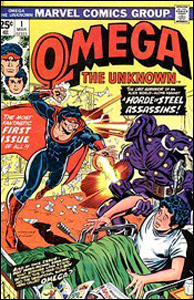Omega the Unknown
| Omega the Unknown | |
|---|---|

Cover art to Omega the Unknown #1, the first appearance of Omega.
Cover art by Ed Hannigan and Joe Sinnott. |
|
| Publication information | |
| Publisher | Marvel Comics |
| First appearance | Omega the Unknown #1 (March 1976) |
| Created by |
Steve Gerber Mary Skrenes Jim Mooney |
| In-story information | |
| Partnerships | James-Michael Starling |
| Notable aliases | "Sam" |
| Abilities | Superhuman strength Flight Energy Burst Projection |
Omega the Unknown was an American comic book published by Marvel Comics from 1976 to 1977, featuring the eponymous fictional character. The series, written by Steve Gerber and Mary Skrenes and illustrated by Jim Mooney, ran for 10 issues before cancellation for low sales. Despite its short run, it has remained as a cult classic due to its intriguing characters and unusual storytelling. A 10-issue series revamping the character was published from 2007 to 2008, written by novelist Jonathan Lethem and illustrated by Farel Dalrymple.
Unlike many other superhero titles, the main focus of Omega the Unknown is not on the super-powered person in an iconic costume and cape. Instead the story largely deals with an unusually mature 12-year-old boy named James-Michael Starling. Through the 10-issue run of the original comic book series it is made clear that there is a connection between the laconic superhero Omega and the strangely analytical child James-Michael, with most issues adding to the mysterious nature of their relationship. Interviewed in 2005 after the sequel to the original series was announced, co-creator Steve Gerber stated that he "wanted to do a series about a real kid who was nobody's sidekick, facing real problems in what today would be called a 'grim 'n gritty' setting." The series was cancelled in 1977, but Steve Gerber promised to wrap up its unfinished plotlines in The Defenders. Gerber was fired by Marvel Comics in 1978 and never completed the storyline. In 2010, Comics Bulletin ranked Gerber and Mooney's run on Omega the Unknown tenth on its list of the "Top 10 1970s Marvels".
In late 1978, Al Milgrom, the editor of The Defenders, assigned writer Steven Grant to complete the story, the conclusion of which was still being sought after in fan correspondence. Grant did this in two issues of The Defenders in 1979, at the end of which most of the original series' characters were killed. While Gerber seemed unhappy with Grant's conclusion, it nevertheless tied up the loose ends of the comic series, and is considered "canon" by Marvel. Grant later wrote that the character held no interest for him, but he had tried to approach writing the story in the way that he felt that Gerber would have, had he been allowed to complete it himself.
...
Wikipedia
